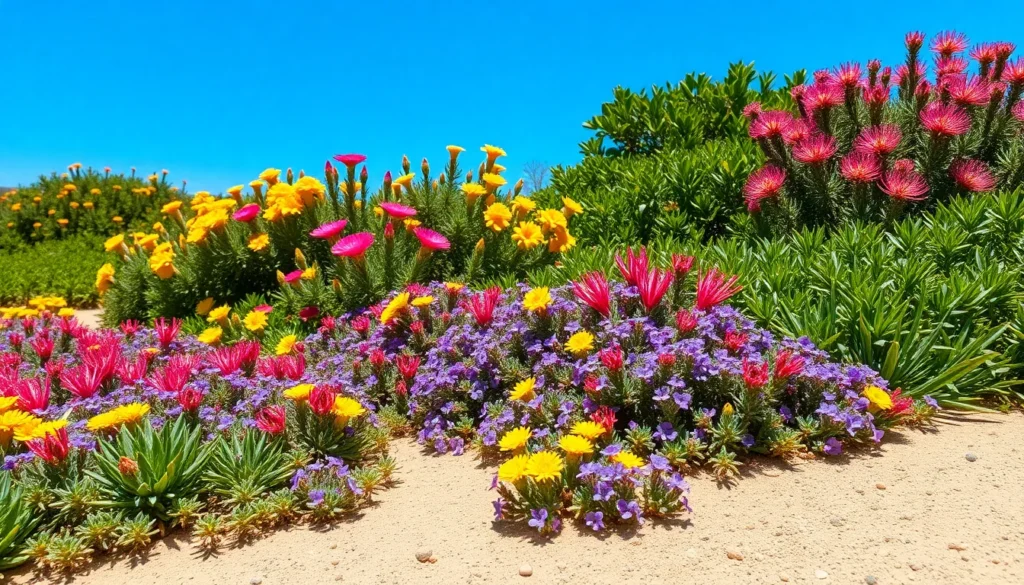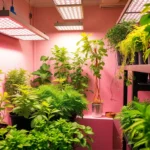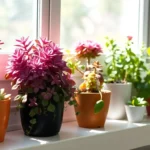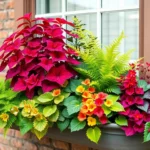We’ve all dreamed of that perfect Australian garden where lush ground cover plants cascade across our industry while requiring minimal maintenance. Whether you’re battling harsh coastal winds scorching inland heat or trying to transform a sloped backyard into something spectacular these hardy beauties offer the ultimate solution for busy gardeners.
Australia’s diverse climate zones present unique challenges that make choosing the right ground cover crucial for long-term success. From drought-tolerant natives that thrive in our unpredictable weather to fast-spreading varieties that’ll quickly fill those bare patches we’re about to explore the most effective options for your exact region.
The secret lies in selecting species that work with our environment rather than against it. We’ll show you how to create stunning low-maintenance landscapes that not only survive but flourish in Australia’s demanding conditions while adding serious value to your property.
Choose Native Australian Ground Cover Plants for Low-Maintenance Gardens
Native Australian ground cover plants offer unmatched resilience in our unique climate conditions. These indigenous species have evolved over thousands of years to thrive in Australia’s challenging environments while requiring minimal water and maintenance.
Grevillea Species for Colorful Blooms
Grevillea ground covers deliver stunning flower displays throughout most of the year with minimal care requirements. We recommend Grevillea ‘Royal Mantle’ for its vibrant red and yellow spider flowers that attract native birds and beneficial insects to your garden space.
Grevillea lanigera (Woolly Grevillea) spreads naturally to form dense mats reaching 30-50cm in height and 2-3 meters in width. This species produces delicate pink or cream flowers from winter through spring while tolerating both drought conditions and light frost exposure.
Grevillea thelemanniana creates spectacular ground coverage with its bright red tubular flowers appearing from late winter to early summer. The plant reaches approximately 1 meter in height and spreads 2-4 meters wide, making it perfect for larger garden areas that need colorful focal points.
Most Grevillea ground covers prefer well-draining soil and full sun to partial shade positions. Pruning requirements remain minimal, with light trimming after flowering periods sufficient to maintain compact growth habits and encourage future blooms.
Pigface for Coastal Conditions
Pigface (Carpobrotus glaucescens) stands as our top recommendation for coastal Australian gardens facing salt spray and sandy soil challenges. This succulent ground cover produces bright purple, pink, or yellow daisy-like flowers from spring through autumn while forming dense protective mats.
Salt tolerance makes Pigface exceptional for beachfront properties where other plants struggle to establish. The thick, fleshy leaves store water efficiently, allowing the plant to survive extended dry periods without supplemental irrigation systems.
Growth characteristics include rapid spreading habits that can cover 2-3 square meters within the first growing season. Pigface reaches 15-20cm in height while creating impenetrable weed barriers that eliminate ongoing maintenance concerns in problem areas.
Soil adaptability extends from pure sand to clay compositions, though drainage remains important for long-term plant health. We’ve observed successful Pigface installations in coastal dunes, rock gardens, and steep embankments where erosion control becomes essential.
Native Violet for Shaded Areas
Native Violet (Viola hederacea) provides the perfect solution for shaded Australian garden spaces where traditional ground covers often fail to thrive. This delicate perennial produces small white and purple flowers throughout spring and summer while spreading via underground runners.
Shade tolerance makes Native Violet ideal for positions under established trees, along fence lines, or in courtyard gardens with limited direct sunlight exposure. The heart-shaped leaves create attractive foliage coverage even when flowers aren’t present during cooler months.
Moisture requirements remain moderate, with Native Violet preferring consistently moist but not waterlogged soil conditions. We recommend incorporating organic mulch around plantings to retain soil moisture and suppress competing weed growth.
Companion planting works exceptionally well with ferns, native grasses, and other shade-loving Australian plants to create layered garden designs. Native Violet spreads slowly but steadily, eventually forming colonies that require minimal intervention once established in suitable growing conditions.
Select Drought-Tolerant Ground Cover Plants for Water-Wise Landscaping
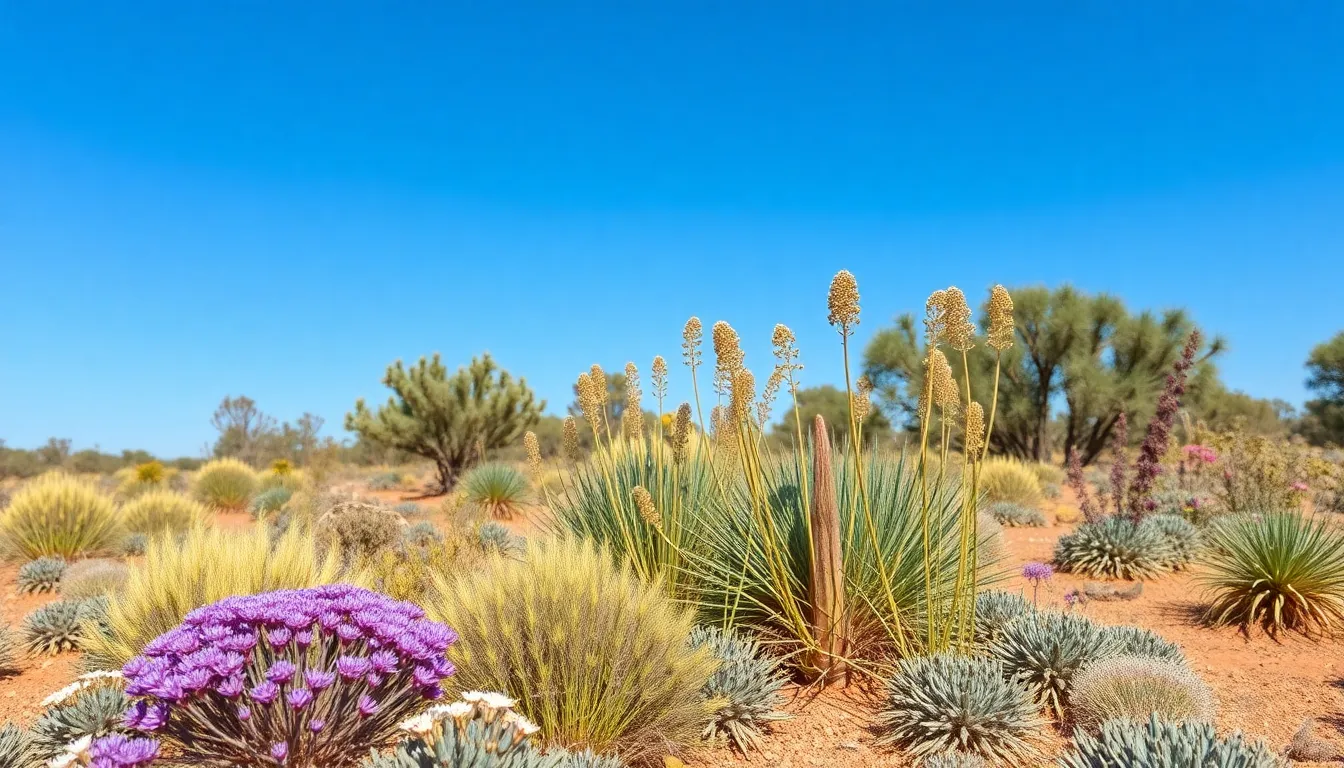
Building on our native plant selections, we’ll explore exceptional drought-tolerant species that excel in Australia’s challenging water-scarce environments. These resilient ground covers reduce irrigation needs while maintaining beautiful landscapes year-round.
Saltbush Varieties for Arid Regions
Aussie Flat Bush™ (Rhagodia spinescens ‘SAB01’) stands out as our top recommendation for extremely dry inland areas. This compact, low-growing saltbush breed thrives with minimal rainfall and requires no supplemental irrigation once established. Its remarkable drought tolerance makes it perfect for challenging Australian landscapes where water conservation is critical.
Traditional saltbush species offer excellent soil stabilization properties in saline and arid conditions. These hardy plants prevent erosion while establishing dense ground coverage that suppresses weeds naturally. We recommend them for slopes, embankments, and areas with poor soil quality where other plants struggle to survive.
Mat Rush for Modern Garden Design
Spiny Mat Rush (Lomandra spp.) delivers exceptional versatility for contemporary Australian gardens. Its neat, architectural form features distinctive grassy foliage that complements modern industry aesthetics perfectly. This tough groundcover tolerates both drought conditions and periodic flooding, making it ideal for unpredictable weather patterns.
Evergreen Baby™ Lomandra excels in challenging soil conditions including poorly drained and non-irrigated areas. Its adaptability to extreme moisture variations ensures consistent performance throughout seasonal changes. We value its longevity and sustainable growth characteristics that reduce long-term maintenance requirements.
Scaevola for Sandy Soils
Scaevola species thrive in sandy, coastal environments where drainage is excellent but nutrients are limited. These spreading groundcovers establish quickly in well-draining substrates typical of Australian coastal regions. Their natural tolerance for poor soils eliminates the need for soil amendments or regular fertilization.
Coastal stabilization becomes effortless with Scaevola’s extensive root systems that bind sandy dunes effectively. These plants produce attractive flowers while preventing erosion in vulnerable coastal gardens. We appreciate their low maintenance requirements and ability to flourish in nutrient-poor conditions where other species fail.
Plant Fast-Growing Ground Cover Plants Australia for Quick Coverage
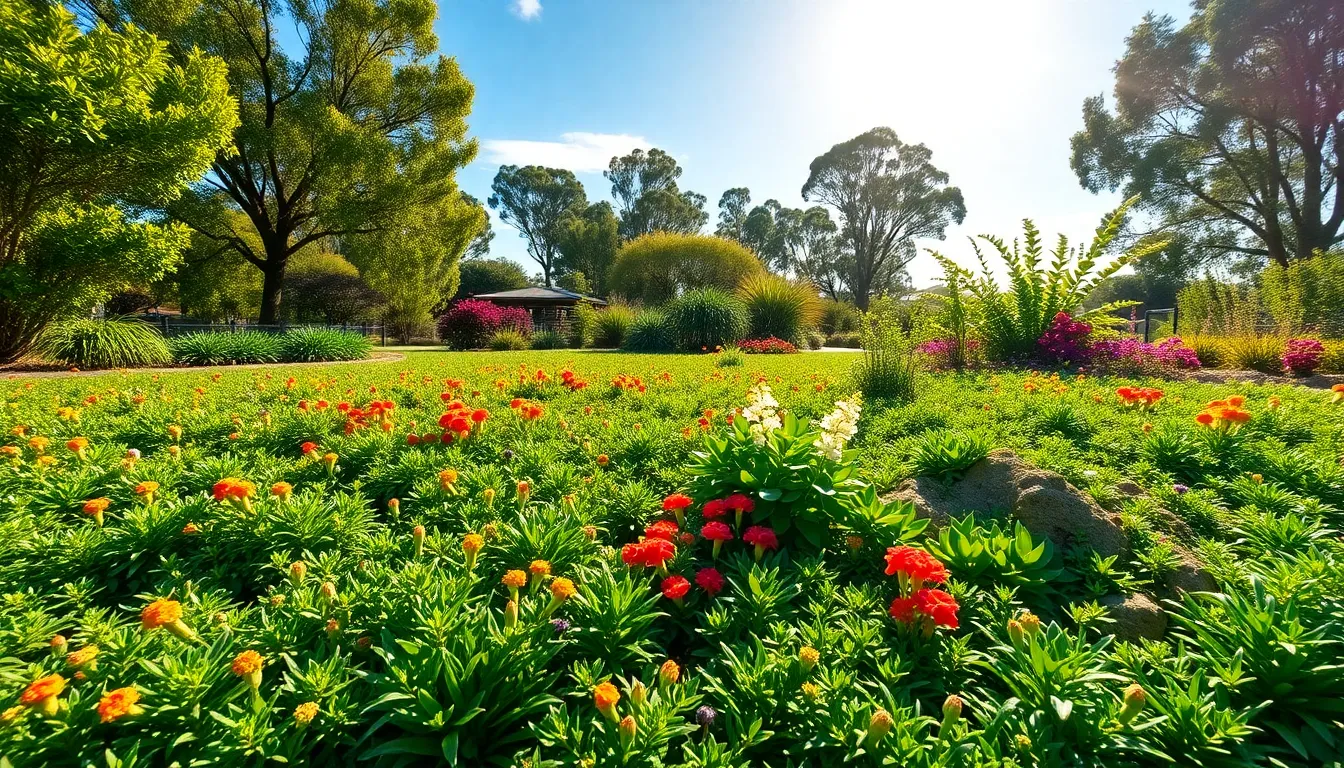
When you need rapid coverage for bare patches or new garden areas, selecting the right fast-growing species makes all the difference in achieving quick results.
Dichondra for Lawn Alternatives
Dichondra repens stands out as our top recommendation for creating a lush lawn alternative that requires minimal maintenance. This creeping plant tolerates light foot traffic while providing excellent coverage in areas where traditional grass struggles. We recommend planting 5-9 plants per square meter depending on how quickly you need full coverage.
Dense planting creates faster establishment but costs more upfront, while sparse planting takes longer but reduces initial investment. The plant thrives with good soil preparation, regular watering during establishment, and appropriate fertilization. Partial shade tolerance makes Dichondra perfect for areas under trees where grass won’t grow, giving you consistent green coverage year-round.
Myoporum for Rapid Establishment
Myoporum parvifolium, commonly known as Creeping Boobialla, delivers exceptional performance for rapid ground coverage across challenging Australian conditions. This hardy native grows 15-30 cm high and spreads 1-2 meters wide, creating dense coverage that effectively suppresses weeds and prevents soil erosion. White star-shaped flowers appear during warmer months, adding attractive seasonal interest to your industry.
| Myoporum Variety | Key Features | Best Use |
|---|---|---|
| Fine Leaf | Delicate foliage, compact growth | Small gardens, tight spaces |
| Broad Leaf | Larger leaves, faster coverage | Large areas, quick establishment |
| Purpurea | Purple foliage, unique color | Decorative accents, contrast planting |
| Pink-flowered | Pink blooms, extended flowering | Ornamental gardens, color displays |
Bank stabilization becomes effortless with Myoporum’s robust root system, making it ideal for slopes and erosion-prone areas. Full sun to part shade adaptability means you can use this versatile ground cover throughout your property without worrying about exact light requirements.
Casuarina Ground Covers for Erosion Control
Casuarina species provide unmatched soil stabilization through their extensive root systems, making them essential for controlling erosion on slopes and embankments. These native Australian plants excel in land rehabilitation projects where other species fail to establish. Strong root networks bind soil particles together, preventing washouts during heavy rains and reducing long-term maintenance needs.
Layered planting combines Casuarina with ground covers like Myoporum for comprehensive erosion control that addresses both surface and deep soil stability. Riparian planting schemes benefit significantly from this combination, creating sustainable answers for waterway protection. Rehabilitation projects across Australia rely on Casuarina species because they adapt to poor soils and harsh conditions while establishing quickly in disturbed areas.
Consider Climate-Specific Ground Cover Plants Australia by Region
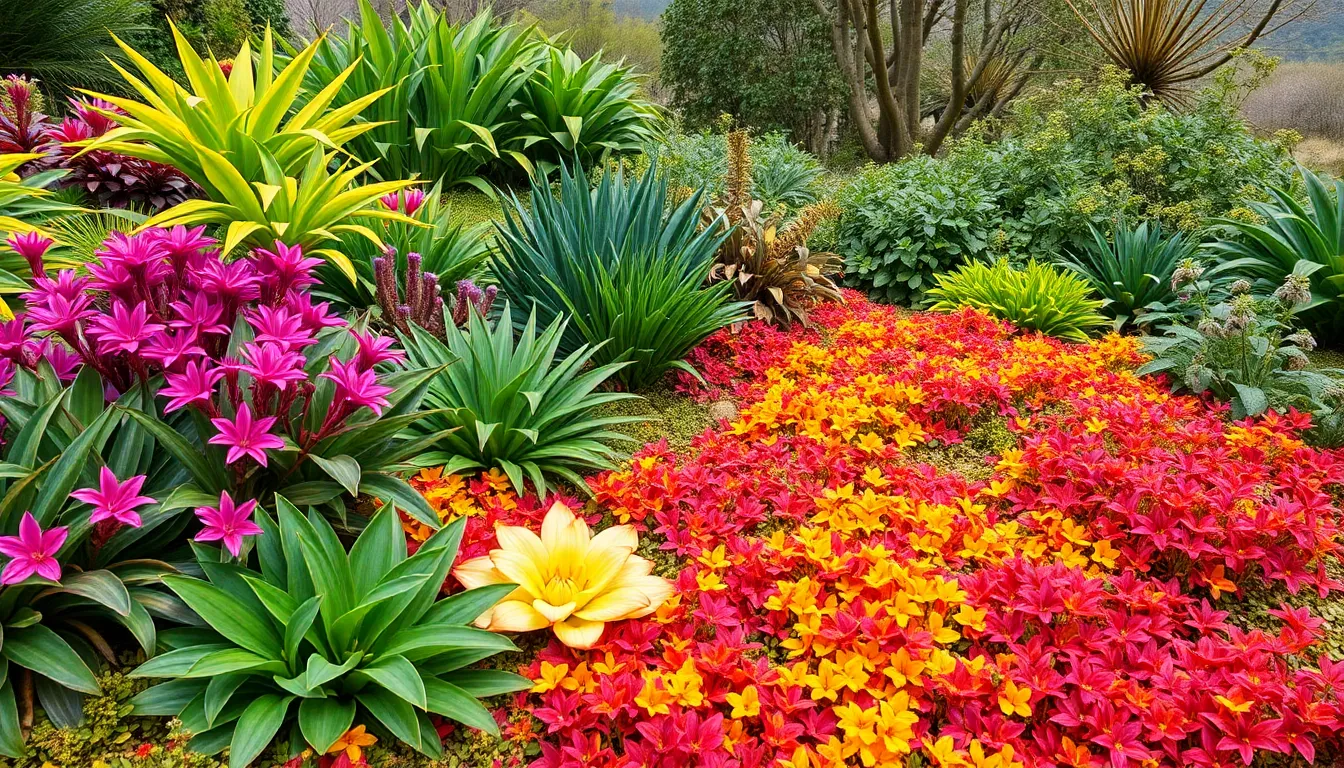
We understand that Australia’s diverse climate zones require customized ground cover selections for optimal garden success. Matching plants to exact regional conditions ensures sustainable growth while minimizing maintenance requirements.
Tropical Options for Northern Australia
Tropic Cascade™ Lomandra stands out as our top recommendation for tropical ground cover applications. This drought-tolerant species thrives in Northern Australia’s intense heat and humidity while requiring minimal care throughout the year.
Little Jess™ Dianella offers exceptional resilience under harsh tropical sun conditions. Native to this region, it features attractive foliage that maintains its appearance even though seasonal rainfall variations and high temperatures.
Creeping Boobialla (Myoporum parvifolium) excels at covering large areas quickly in tropical environments. We recommend this species for slope stabilization projects where its dense mat formation suppresses weeds effectively while retaining soil moisture.
Dense mat formation characterizes these tropical selections, providing natural weed suppression and moisture retention benefits. Their soil stability properties make them ideal for erosion control in Northern Australia’s challenging climate conditions.
Temperate Choices for Southern Regions
Dichondra repens (Kidney Weed) serves as our premier temperate ground cover choice for Southern Australian gardens. This versatile plant forms dense green carpets in both sun and shade while tolerating moderate foot traffic in cities like Melbourne and Adelaide.
Carex appressa thrives in temperate climates with its native sedge characteristics. We recommend this species for wetter garden areas and shaded conditions where frost tolerance becomes essential during cool winters.
Agapanthus provides both aesthetic appeal and functional benefits in temperate regions. Hardy and drought-tolerant, it produces decorative flowers while maintaining dense growth patterns that contribute to soil retention.
Frost tolerance defines these temperate selections, balancing visual appeal with practical functionality. Their moisture conservation abilities help gardens maintain health through Southern Australia’s variable seasonal conditions.
Mediterranean Plants for Western Australia
Tanika® Lomandra and Katrinus Lomandra represent our top Mediterranean climate recommendations for Western Australian gardens. Both species demonstrate exceptional drought tolerance while adapting to sandy or poor soil conditions typical in this region.
Australian Violet offers unique benefits for shaded Mediterranean garden areas. This colorful ground cover attracts pollinators while providing visual interest in areas where other species might struggle with hot, dry summer conditions.
Native Lomandra species excel in Western Australia’s challenging environment due to their remarkable resilience. Their low water requirements make them sustainable choices for gardens experiencing minimal irrigation during extended dry periods.
Drought resistance characterizes these Mediterranean selections, enabling them to reduce soil erosion with minimal water input. Their ability to thrive in poor soil conditions makes them essential for sustainable landscaping in Western Australia’s unique climate zone.
Install Ground Cover Plants Australia for Specific Garden Functions
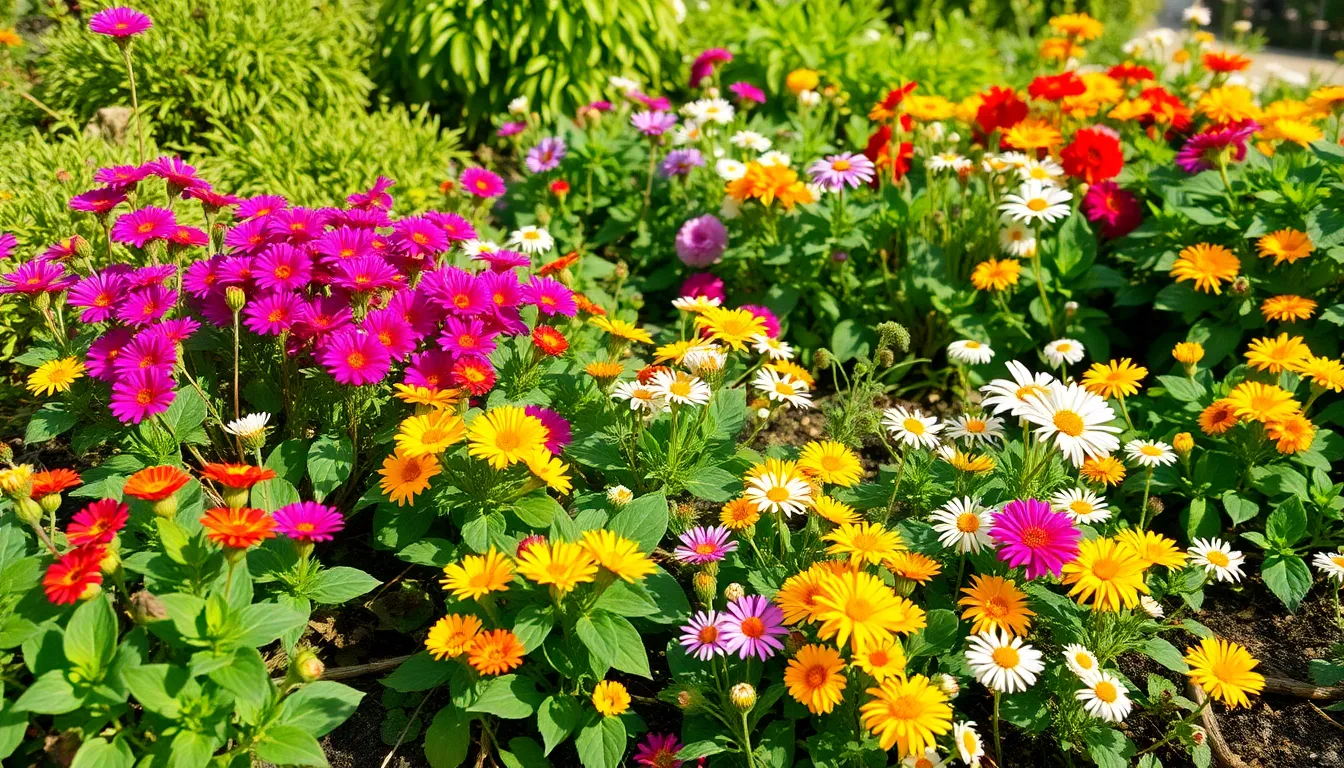
We’ll explore how selecting the right ground cover plants can transform your Australian garden into a multifunctional industry that serves exact purposes while maintaining natural beauty.
Edible Ground Covers for Permaculture Gardens
Nasturtium transforms permaculture gardens by providing edible leaves, flowers, and seed pods while attracting beneficial pollinators. This versatile plant self-seeds prolifically and creates natural partnerships with sweet potatoes to ensure year-round soil coverage.
Sweet potato offers dense summer coverage that prevents weed growth and soil erosion while producing nutritious tubers. We recommend pairing it with nasturtium to maintain continuous ground protection throughout seasonal changes.
New Zealand Spinach thrives in drought conditions as a succulent ground cover perfect for coastal areas and warmer climates. Its drought-tolerant nature suppresses weeds and retains soil moisture while providing edible leaves suitable for cooking applications.
Oregano serves dual garden purposes as both a culinary herb and hardy ground cover that tolerates drought conditions. This Mediterranean favorite thrives in full sun or partial shade environments across most Australian regions.
Cranberry requires patience but delivers long-term benefits as an edible fruiting ground cover suited to moist, cool areas. While establishment takes 3-5 years, cranberries provide sustainable fruit production in gardens with adequate chill hours.
Flowering Species for Pollinator Gardens
Nasturtium attracts essential pollinators including bees and butterflies with its bright, cheerful flowers that enhance garden biodiversity. These colorful blooms improve pollination rates for surrounding plants while adding aesthetic appeal to industry designs.
Sweet violet creates pollinator havens in shaded garden areas where other flowering ground covers struggle to establish. We’ve observed these delicate flowers supporting beneficial insects throughout extended blooming periods.
Chamomile provides continuous blooms that support pollinator populations while offering medicinal and culinary benefits for homeowners. This fragrant ground cover releases pleasant aromas when walked upon, creating sensory garden experiences.
Flowering ground covers enhance network health by creating habitats for beneficial insects that naturally control garden pests. Research shows these plantings reduce the need for chemical interventions while supporting local wildlife populations.
Evergreen Options for Year-Round Interest
Oregano maintains foliage throughout multiple seasons as one of the most reliable evergreen herb ground covers for Australian gardens. Its persistent greenery provides continuous soil coverage even during dormant periods of other plants.
Strategic plant combinations ensure constant coverage by pairing seasonal varieties like nasturtium with evergreen species. We recommend planning garden layouts that account for die-back periods and summer dormancy cycles.
Evergreen herbs offer sustainable answers for gardeners seeking low-maintenance ground coverage that doesn’t require replanting. These perennial options establish strong root systems that improve soil structure over time.
Year-round greenery reduces maintenance demands while providing consistent erosion control and weed suppression. Combining multiple evergreen species creates resilient landscapes that withstand Australia’s variable climate conditions without losing visual appeal.
Maintain Your Australian Ground Cover Plants for Long-Term Success

Successful establishment and thriving growth of your Australian ground covers depend on consistent care practices that support their natural resilience. We’ll guide you through the essential maintenance routines that ensure your plants provide dense coverage and lasting beauty for years to come.
Watering Requirements and Schedules
Deep weekly watering forms the foundation of healthy ground cover maintenance during Australia’s warmer months. We recommend checking soil moisture by inserting your finger into the top inch of soil – when it feels dry, it’s time to water thoroughly rather than applying light surface sprinkles.
Summer irrigation schedules should focus on penetrating water deeply to reach root zones, typically requiring about four gallons per hour applied four times weekly for native species. Evening watering sessions reduce evaporation losses and minimize plant stress during peak heat periods.
Competing root systems beneath established trees create unique challenges for ground cover hydration. Dense tree canopies often block natural rainfall from reaching soil surfaces, requiring us to increase watering frequency and monitor moisture levels more closely in these areas.
Seasonal adjustments become crucial as temperatures drop during cooler months. We reduce irrigation frequency while maintaining deep watering practices to encourage strong root development throughout winter dormancy periods.
Pruning and Trimming Techniques
Spring pruning sessions work best for evergreen ground covers, allowing fresh growth to emerge as temperatures warm and daylight hours increase. We focus on removing any winter damaged branches after new shoots begin appearing to avoid cutting healthy tissue.
Tip pruning methods encourage bushier, denser growth patterns that create better ground coverage and weed suppression. Light trimming of growing tips stimulates lateral branching, resulting in fuller plant development over time.
Autumn maintenance suits deciduous ground covers better, timing cuts during frost free periods when plants enter dormancy. We avoid heavy pruning that might damage shallow root systems common in most ground cover species.
Shape control techniques help manage spreading patterns and prevent overgrowth into unwanted areas. Regular light trimming maintains desired boundaries while promoting healthy vigor throughout the growing season.
Fertilizing Native Ground Covers
Organic compost applications provide the most beneficial nutrition for Australian native ground covers during spring months. We apply a thin layer around established plants before adding fresh mulch, allowing natural decomposition to slowly release nutrients.
Slow release fertilizers like Osmocote NPK blends work exceptionally well when applied a few months after initial planting. We typically reapply these balanced formulations in early spring to support steady growth throughout active growing periods.
Low maintenance nutrition reflects the natural adaptation of most native species to Australia’s variable soil conditions. Excessive fertilizing can actually harm these plants, so we focus on minimal but consistent feeding approaches.
First year support requires slightly more attention to nutrition as plants establish root systems and develop coverage density. We monitor growth responses and adjust feeding schedules based on plant performance and local soil conditions.
Design Creative Landscapes Using Ground Cover Plants Australia
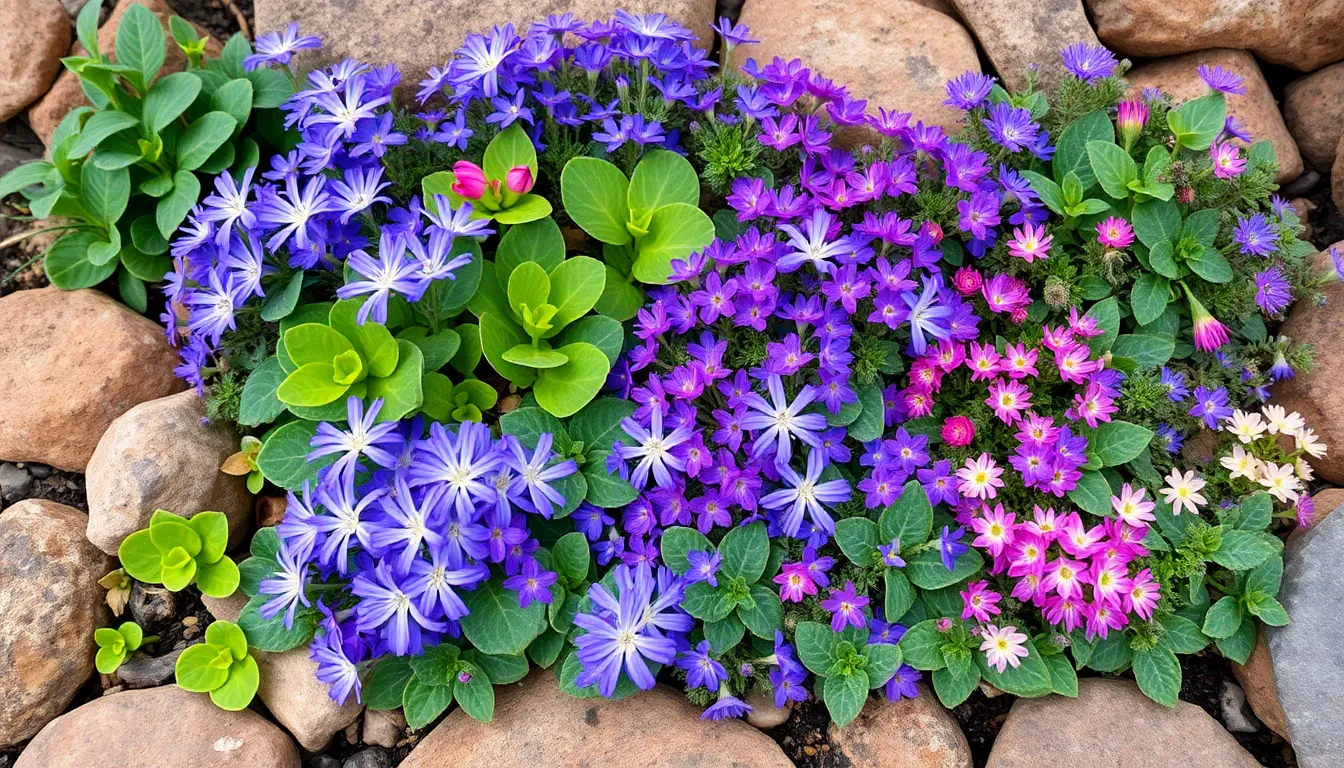
Creative industry design with Australian ground covers transforms ordinary spaces into stunning, functional gardens that showcase native beauty while solving practical challenges.
Rock Garden Combinations
Rock gardens benefit tremendously from native ground covers that complement stone textures and create visual harmony. Cut-leaf Daisy delivers striking lavender to blue daisy-like flowers that beautifully soften harsh rock edges while providing continuous seasonal interest. Australian Violet thrives in the shaded pockets between rocks, displaying heart-shaped leaves and delicate purple-white flowers that attract beneficial pollinators to your garden network.
We recommend combining these species with Grevillea obtusifolia ‘Gin Gin Gem’ for added height variation and color contrast. This compact evergreen shrub reaches 30cm high and spreads 1-3m wide, producing attractive pink and cream flowers that create a stunning backdrop against weathered stones. The combination offers multiple flowering periods throughout the year while requiring minimal maintenance once established.
Slope Stabilization Projects
Slope stabilization becomes effortless when we select ground covers specifically adapted for erosion control and challenging terrain. Creeping Boobialla stands out as our top choice for steep banks, featuring dense growth patterns and exceptional drought resistance that prevents soil erosion effectively. Its small star-shaped white flowers and fine green foliage create an attractive carpet while its extensive root system anchors soil particles securely.
Grevillea varieties like ‘Gin Gin Gem’ excel on moderate slopes, offering dual benefits of erosion control and wildlife habitat creation. These plants establish quickly in sunny, dry conditions and spread naturally to form dense coverage that stabilizes loose soil. Their drought tolerance makes them perfect for areas where irrigation systems can’t reach easily.
Border and Edge Plantings
Border plantings define garden spaces while creating smooth transitions between different industry elements. Grevillea obtusifolia ‘Gin Gin Gem’ maintains a tidy, low-growing habit that provides perfect definition along pathways and garden beds without overwhelming nearby plantings. Its visually appealing flowers add seasonal interest while attracting birds and beneficial insects to your industry.
Pratia pedunculata works exceptionally well for formal edge plantings, creating clean lines with its compact growth pattern and delicate white flowers. White Creeping Thyme offers another excellent choice for areas around stepping stones or pavers, maintaining flat growth while producing fragrant flowers over extended periods. Myoporum ‘Yareena™’ creates lush green carpets along borders, tolerating poor soil conditions and providing reliable coverage in full sun exposure.
Source Quality Ground Cover Plants Australia from Reliable Suppliers
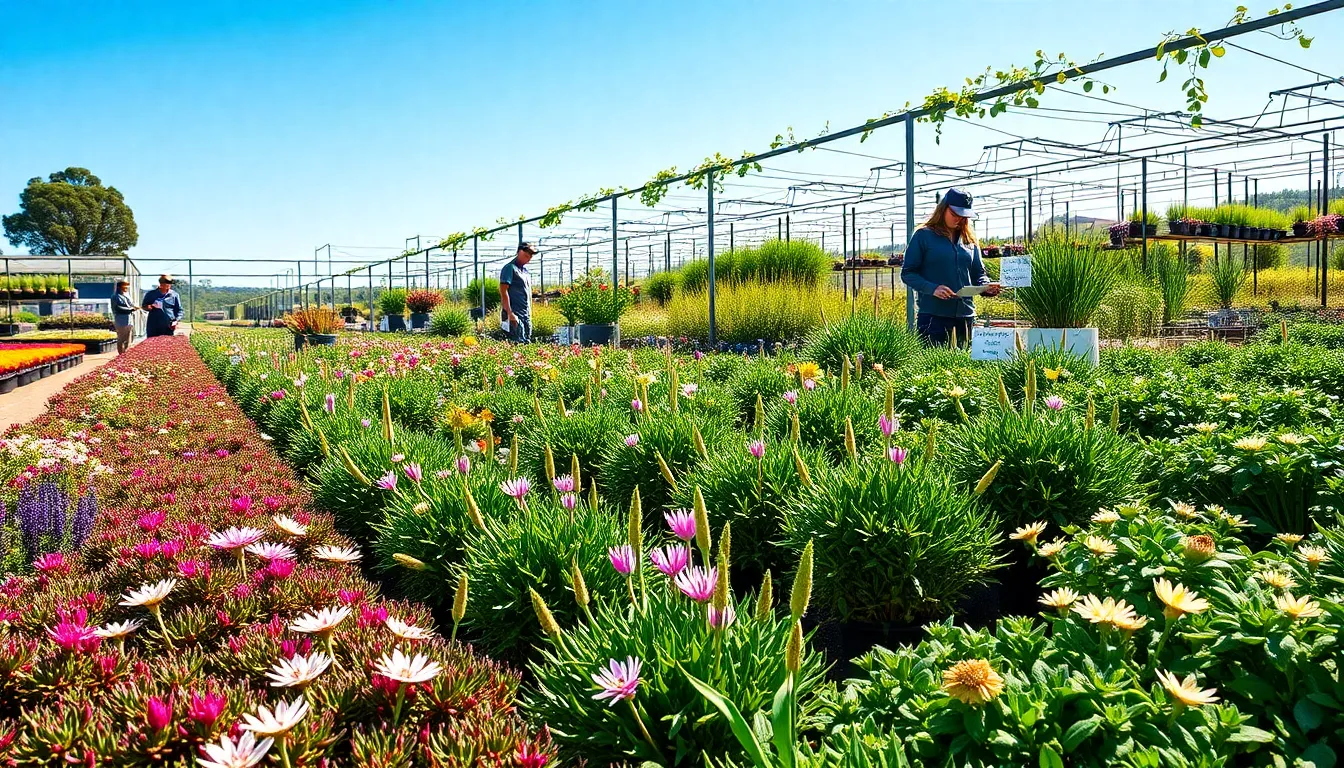
Finding the right suppliers ensures we’ll receive healthy, well-adapted plants that establish quickly in our Australian gardens. Quality sourcing makes the difference between thriving ground cover installations and disappointing failures.
Native Plant Nurseries Across Australia
Native plant nurseries specialize in Australian ground cover species and offer expert knowledge about local growing conditions. We can find specialized varieties like Ground Hug™ Myoporum and Blue Horizon™ Eremophila at these dedicated facilities, where staff understand the exact needs of each species. Staff members provide valuable advice on soil preparation, planting techniques, and ongoing care for varieties like Aussie Rambler™ Carpobrotus glaucescens.
Regional nurseries stock plants suited to local climate zones, ensuring we receive specimens adapted to our exact environmental conditions. Many nurseries grow their own stock from local seed sources, providing us with plants that have already adapted to regional rainfall patterns and soil types. Specialized facilities often maintain mother plants of popular varieties like Grevillea ‘Poorinda Royal Mantle’ and Scaevola albida ‘Mauve Carpet’, ensuring consistent quality and availability.
Visiting native nurseries allows us to inspect plants before purchase and select the healthiest specimens for our projects. Expert staff can recommend exact cultivars based on our site conditions, whether we need drought tolerant options like Aussie Flat Bush™ Rhagodia spinescens or coastal varieties for sandy soils.
Online Retailers and Mail-Order Options
Online suppliers provide access to specialized ground cover varieties that may not be available locally. We can order exact cultivars like Westringia fruticosa ‘Flat’n’Fruity’ and Goodenia ovata ‘Gold Cover’ directly from growers across Australia. Mail order options expand our plant selection beyond what local retailers typically stock.
Reputable online retailers offer detailed growing information and care instructions with each purchase, helping us understand exact requirements for each variety. Many suppliers provide plant guarantees and replacement policies, giving us confidence in our investment. Seasonal availability information helps us plan our planting schedule around optimal establishment periods.
Bulk ordering through online channels often provides cost savings for larger ground cover installations. Shipping methods protect plants during transport, with many retailers using specialized packaging to ensure healthy arrival. Review systems help us identify reliable suppliers based on other customers’ experiences with plant quality and service.
Local Garden Centers and Plant Sales
Garden centers provide convenient access to common ground cover varieties and seasonal availability throughout the year. We can examine plants firsthand and receive immediate advice from horticultural staff about establishment techniques. Local centers often stock regionally appropriate varieties that perform well in our exact area.
Community plant sales and gardening events offer opportunities to purchase less common varieties from local growers and enthusiasts. These venues frequently feature native plant societies that specialize in propagating Australian ground covers from local seed sources. Seasonal sales events provide cost effective options for larger planting projects.
Established garden centers maintain relationships with quality wholesale growers, ensuring consistent plant health and variety authenticity. Staff knowledge about local growing conditions helps us select appropriate species for exact microclimates in our gardens. Return policies and plant health guarantees provide additional security for our ground cover investments.
Conclusion
Ground cover plants offer us the perfect solution for creating stunning Australian gardens that work with nature rather than against it. We’ve explored how native species like Grevillea and Pigface can transform challenging landscapes into thriving ecosystems while requiring minimal water and maintenance.
The key to success lies in matching plants to our exact climate zones and soil conditions. Whether we’re dealing with coastal salt spray drought-prone inland areas or shaded southern gardens there’s a ground cover solution that’ll flourish in our unique environment.
By combining practical benefits like erosion control and weed suppression with aesthetic appeal we can create landscapes that enhance our property values while supporting local wildlife. These resilient plants prove that sustainable gardening doesn’t mean compromising on beauty – it means working smarter with Australia’s natural advantages.
Frequently Asked Questions
What are the best native Australian ground cover plants for low maintenance gardens?
The top native Australian ground covers include Grevillea varieties like ‘Royal Mantle’ for colorful blooms, Pigface (Carpobrotus glaucescens) for coastal areas, and Native Violet (Viola hederacea) for shaded spots. These plants are naturally adapted to Australian conditions, require minimal water once established, and provide excellent coverage while supporting local wildlife.
Which ground cover plants work best in drought-prone areas?
Aussie Flat Bush™ (Rhagodia spinescens), Spiny Mat Rush (Lomandra spp.), and Scaevola species are exceptional for drought conditions. These plants require minimal irrigation once established, can survive extreme dry periods, and actually thrive in water-scarce environments. They’re perfect for inland areas and regions with water restrictions.
What are the fastest growing ground covers for quick garden coverage?
Dichondra repens, Myoporum parvifolium (Creeping Boobialla), and Casuarina species establish rapidly and spread quickly. Dichondra works well as a lawn alternative, while Creeping Boobialla effectively suppresses weeds. These fast-growing options can cover bare patches within months and provide immediate weed control benefits.
Which ground covers are suitable for different Australian climate zones?
Northern Australia benefits from Tropic Cascade™ Lomandra and Little Jess™ Dianella for tropical conditions. Southern regions suit Dichondra repens and frost-tolerant Carex appressa. Western Australia thrives with Tanika® Lomandra and drought-resistant varieties. Choose plants specifically adapted to your local climate zone for best results.
Can ground cover plants be both decorative and edible?
Yes! Nasturtium, Sweet Potato, New Zealand Spinach, and Oregano provide both beauty and food. These edible ground covers attract pollinators, suppress weeds, and offer fresh ingredients for cooking. They’re particularly valuable in permaculture gardens where functionality and aesthetics combine seamlessly.
How do I maintain ground cover plants for long-term success?
Provide deep weekly watering during warmer months, prune evergreen varieties in spring and deciduous ones in autumn. Use organic compost and slow-release fertilizers sparingly, as most native ground covers prefer lean soils. Avoid overwatering and excessive feeding, which can reduce plant resilience and flowering.
Where can I buy quality Australian ground cover plants?
Source plants from specialized native plant nurseries, reputable online retailers, local garden centers, and community plant sales. Native nurseries offer the best species selection and expert advice. Always choose healthy, well-established specimens from suppliers who understand local growing conditions and can provide ongoing support.

